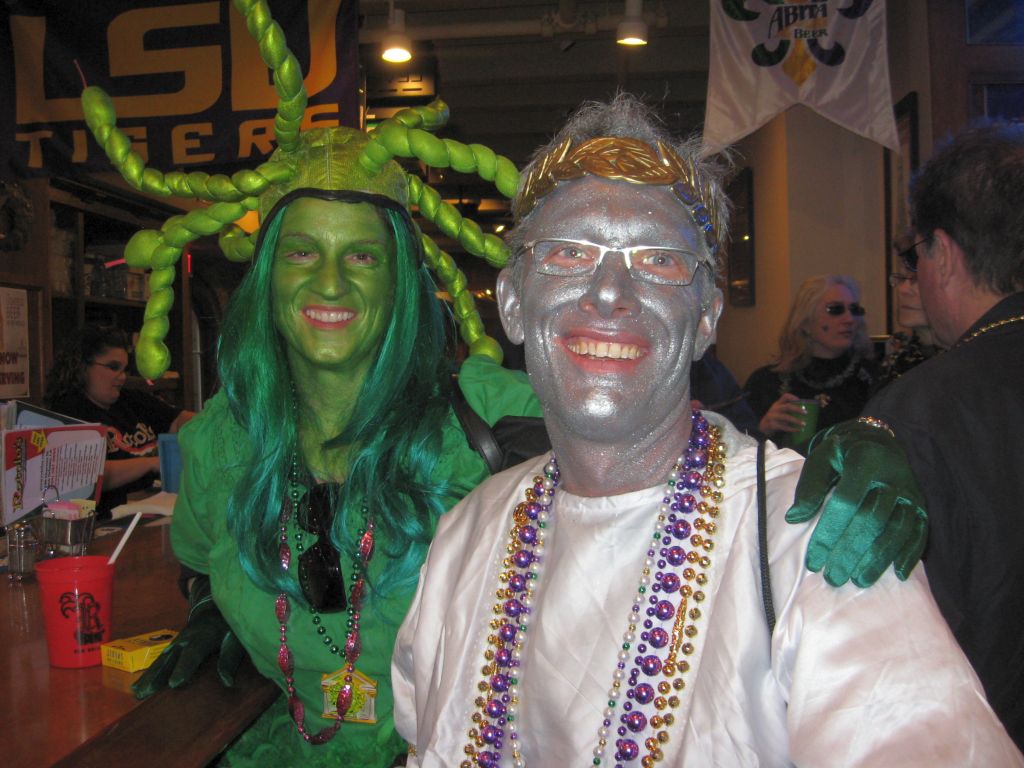Blue Highways: Abbeville, Louisiana
Unfolding the Map
Click on Thumbnail for MapHappy New Year!!! In this January 1, 2011 post, we stop for some oysters in Abbeville with William Least Heat-Moon (LHM), and reflect on whether disasters, human- and nature-made, will lead to the end of the oyster industry in Acadiana and take with them a unique culture and cuisine. Read on, and taste these morsels with us! And click on the thumbnail at right to see where on the map, and where in our journey, Abbeville is located.
Book Quote
"My last chance at Cajun food was Abbeville, a town with two squares: one for the church, one for the courthouse. On the walk at Black's Oyster Bar a chalked sign: FRESH TOPLESS SALTY OYSTERS. Inside, next to a stuffed baby alligator, hung an autographed photo of Paul Newman, who had brought the cast of The Drowning Pool to Black's while filming near Lafayette. Considering that a recommendation, I ordered a dozen topless ("on the halfshell") and a fried oyster loaf (oysters and hot pepper garnish heaped between slices of French bread). Good enough to require a shrimp loaf for the road."
Blue Highways: Part 3, Chapter 14
 Black's Oyster Bar in Abbeville, Louisiana. William Least Heat-Moon ate here on his way through town. Photo at nssf04's photostream at Flickr. Click on photo to go to host site.
Black's Oyster Bar in Abbeville, Louisiana. William Least Heat-Moon ate here on his way through town. Photo at nssf04's photostream at Flickr. Click on photo to go to host site.
Abbeville, Louisiana
One last Cajun meal, one last batch of oysters. When LHM went through Abbeville and stopped at Black's Oyster Bar, I’m sure the thought never crossed his mind that oysters, which seemed so plentiful along with crawfish and shrimp, would quite possibly become a commodity that would be one day difficult to find.
Elsewhere in this blog I opined about how I love oysters. I wrote about getting them on the half shell. I may have mentioned that one of the best things to do is make your own oyster sauce – a little horseradish combined with some Tabasco or Louisiana Hot Sauce and you have yourself a bit of a kick to put on them. Then, you put the shell to your lips, tip your head back, and let them slide with the hot sauce right on down. Whether you chew them, or just let them go down your throat alive, they’re all good.
I may have also written that two fried delicacies that practically made me see God involved oysters. The garlic-oyster po-boy, served in some fine New Orleans establishments but made particularly well by Liuzza’s by the Track just off Esplanade Avenue, is so good that I could literally eat one every day. I’d weigh 300 pounds by now if I did, but they are that tasty that I wouldn’t care. I could be having a coronary because of arterial sclerosis caused by too many garlic oyster po-boys, and if I were clutching my heart with a bit of one in my mouth, I’d consider it my honor to have died that way.
But the best, most wonderful oyster dish I had was something that even I had trouble envisioning until I tasted it. Fried oysters wrapped in bacon. Yes, it’s true. Fried oysters taste like heaven, and then wrap some bacon around them, (because everything tastes better with bacon, right?) and you have a heavenly treat that’s a major sin to eat. After eating one of those get out your rosary, because you need to do penance right there…and consign yourself to hell if you eat a whole meal of them. I saw the light and never looked back after that meal.
I don’t revisit these things just to remember. I revisit them because frankly, with hurricanes and with large oil spills, I fear for the fishing industry on the Louisiana coast. Oyster beds that have been harvested for decades were put in danger by these events. Shrimping businesses passed down through generations are in trouble. These are major economic engines for Louisiana, particularly Cajuns, and a major reason that tourists go to New Orleans and the rest of Louisiana. They are in mortal danger. I want to go back and have my shrimp gumbo and my oyster po-boys. I want future generations to be able to experience these delights. LHM says that somewhere in Louisiana there has to be a bad chef but he never found one. I know that from living in Louisiana, you have to go out of your way to find bad food there. I know that there will be adaptation and renewal, and yet I worry about a culture, a cuisine and a way of life that could be gone within a generation.
I will be back in New Orleans in March. I will stay with good friends and find good food – the best things that Louisiana has to offer. And I will hope that these wonderful aspects of Louisiana that are unique to the United States, that make our rapidly homogenizing country a little more interesting, will be around for a while, and hopefully for a long time. "Laissez les bontemps roulet," goes the French saying – let the good times roll. I’m planning to take as much advantage of these cultural gems for as long as I can, and will by eating gumbo and oysters, dance to some Cajun music, and wash it all down with an Abita Amber or a cold Dixie. Laissez le bontemps roulet, and let them live long!
If you want to know more about Abbeville
Abbeville's "5000 egg" giant omelette celebration
Black's Oyster Bar review
City of Abbeville
VermilionToday (newspaper)
Wikipedia: Abbeville
Next up: Kaplan, Louisiana




 Saturday, January 1, 2011 at 8:53AM
Saturday, January 1, 2011 at 8:53AM

